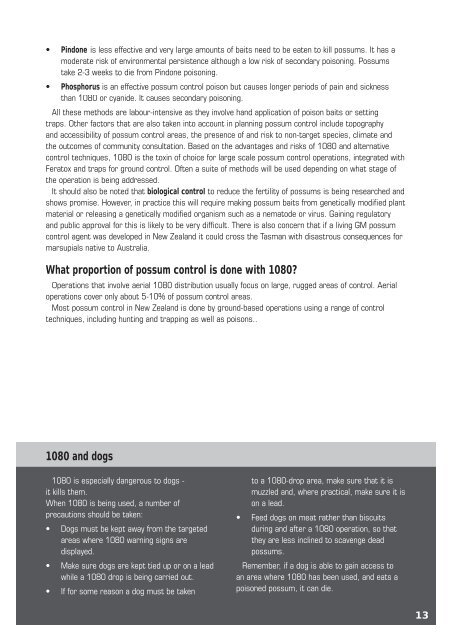National Possum Control Agencies - Department of Conservation
National Possum Control Agencies - Department of Conservation
National Possum Control Agencies - Department of Conservation
Create successful ePaper yourself
Turn your PDF publications into a flip-book with our unique Google optimized e-Paper software.
• Pindone is less effective and very large amounts <strong>of</strong> baits need to be eaten to kill possums. It has a<br />
moderate risk <strong>of</strong> environmental persistence although a low risk <strong>of</strong> secondary poisoning. <strong>Possum</strong>s<br />
take 2-3 weeks to die from Pindone poisoning.<br />
• Phosphorus is an effective possum control poison but causes longer periods <strong>of</strong> pain and sickness<br />
than 1080 or cyanide. It causes secondary poisoning.<br />
All these methods are labour-intensive as they involve hand application <strong>of</strong> poison baits or setting<br />
traps. Other factors that are also taken into account in planning possum control include topography<br />
and accessibility <strong>of</strong> possum control areas, the presence <strong>of</strong> and risk to non-target species, climate and<br />
the outcomes <strong>of</strong> community consultation. Based on the advantages and risks <strong>of</strong> 1080 and alternative<br />
control techniques, 1080 is the toxin <strong>of</strong> choice for large scale possum control operations, integrated with<br />
Feratox and traps for ground control. Often a suite <strong>of</strong> methods will be used depending on what stage <strong>of</strong><br />
the operation is being addressed.<br />
It should also be noted that biological control to reduce the fertility <strong>of</strong> possums is being researched and<br />
shows promise. However, in practice this will require making possum baits from genetically modifi ed plant<br />
material or releasing a genetically modifi ed organism such as a nematode or virus. Gaining regulatory<br />
and public approval for this is likely to be very diffi cult. There is also concern that if a living GM possum<br />
control agent was developed in New Zealand it could cross the Tasman with disastrous consequences for<br />
marsupials native to Australia.<br />
What proportion <strong>of</strong> possum control is done with 1080?<br />
Operations that involve aerial 1080 distribution usually focus on large, rugged areas <strong>of</strong> control. Aerial<br />
operations cover only about 5-10% <strong>of</strong> possum control areas.<br />
Most possum control in New Zealand is done by ground-based operations using a range <strong>of</strong> control<br />
techniques, including hunting and trapping as well as poisons..<br />
1080 and dogs<br />
1080 is especially dangerous to dogs -<br />
it kills them.<br />
When 1080 is being used, a number <strong>of</strong><br />
precautions should be taken:<br />
• Dogs must be kept away from the targeted<br />
areas where 1080 warning signs are<br />
displayed.<br />
• Make sure dogs are kept tied up or on a lead<br />
while a 1080 drop is being carried out.<br />
• If for some reason a dog must be taken<br />
to a 1080-drop area, make sure that it is<br />
muzzled and, where practical, make sure it is<br />
on a lead.<br />
• Feed dogs on meat rather than biscuits<br />
during and after a 1080 operation, so that<br />
they are less inclined to scavenge dead<br />
possums.<br />
Remember, if a dog is able to gain access to<br />
an area where 1080 has been used, and eats a<br />
poisoned possum, it can die.<br />
13

















